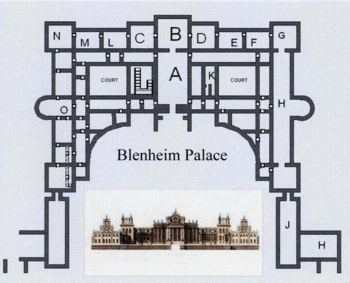Corps de logis

Corps de logis (French pronunciation: [kɔʁ də lɔʒi]) is an architectural term referring to the principal block of a large, usually classical, mansion or palace. It contains the principal rooms, state apartments and an entry.[1] The grandest and finest rooms are often on the first floor above the ground level: this floor is the piano nobile.
The corps de logis is usually flanked by lower secondary wings. When the secondary wings form a three sided courtyard, the courtyard is known as the Cour d'Honneur.
Examples of a corps de logis can be found in many of the most notable Classical Era buildings of Europe including the Palace of Versailles, Blenheim Palace and the Palazzo Pitti.
In France, the principal block of medieval castles and manor houses is often referred to as the corps de logis.
References
- ↑ Curl, James Stevens (2006). Oxford Dictionary of Architecture and Landscape Architecture, 2nd edition. Oxford and New York: Oxford University Press, p. 204. ISBN 978-0-19-860678-9.